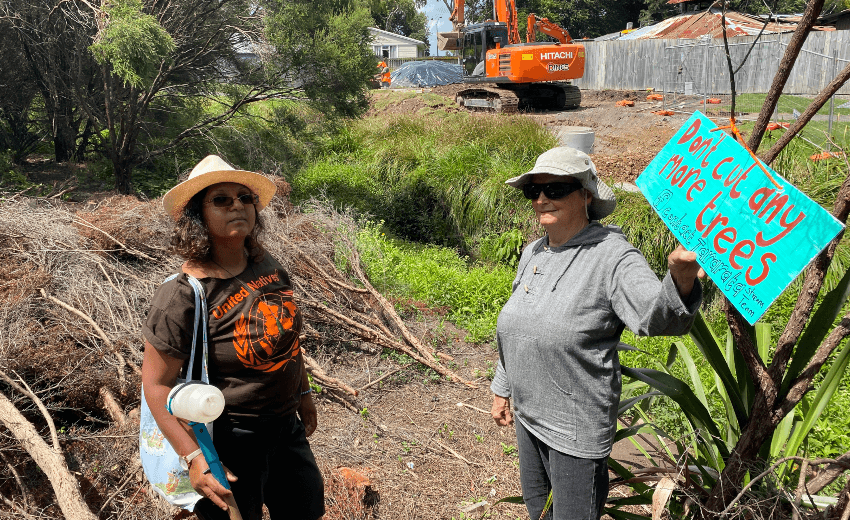A community is outraged after Auckland Council granted consent for a row of trees planted by local kids to be removed along a revitalised waterway in South Auckland, reports Justin Latif.
An Auckland Council decision to give contractors the all-clear to chop down 12 mānuka and kānuka trees shading Māngere’s Tararata Stream has angered and bemused volunteers who planted the shrubs with council funding.
The contractors were removing trees to prepare the site for infrastructure construction as part of a Kāinga Ora-led housing development in the area.
Tararata Stream team’s Pragna Patel and Julia Tu’ineau say the vegetation removal could be a significant setback in their 20 year struggle to turn an ugly concrete drain into a thriving habitat for endangered species like the giant kōkopu and long-finned eel.
“We get children to put plants in, funded by Auckland Council, and then contractors come and kill them,” Patel says.
“Accumulatively, it’s been a couple of hundred hours of community time, if you look at all the different activities that it takes to get these trees planted. And community volunteer time is really hard to come by.”
Tu’ineau, who first began working on the stream in 2000, coordinates regular planting projects with the help of Wai Care, an Auckland Council programme aimed at supporting communities to care for and revitalise their local waterways.
“For almost a decade, Wai Care has been supplying the plants and also doing the preparation and maintenance for this stream. And the plantings along here have been done by the local kura kaupapa,” says Tu’ineau.
The Māngere resident says removing the trees in the height of summer puts the endangered species currently living in the stream at great risk.
“The trees shade the stream, which stops the oxidation of the water, and by reducing the amount of oxygen weeds growing and cooling the water down, it helps the fish life to survive.”
In response to the massive Kāinga Ora-led housing development in the area, a number of local advocates have formed the Māngere Housing Community Regeneration group to liaise with the government’s state housing arm so local residents’ concerns are taken into account during this large construction project.
The group’s spokesperson Vicki Sykes says this incident has to be the catalyst for better local engagement from council and government agencies alike.
“While council approved the removal of the trees, Piritahi, under Kāinga Ora’s mandate, should have known to talk to the community before even applying for consent,” says Sykes.
“For our community to have confidence in this new development, it is imperative that those delivering projects in this area demonstrate they understand who the key stakeholders are and how their actions impact the community. It was especially disappointing given the two years of meetings our group has had with Kāinga Ora management to represent the needs of the Māngere community.
“There needs to be a regenerative approach adopted that sees the value of the waterways for the health of the community and the earth, and not just as storm and wastewater channels,” adds Sykes. “The learning from this error has to be translated into all current and future local developments by council and Kāinga Ora.”
Kāinga Ora’s acting project director for the Māngere development Shanon Tapp says while the removal was approved by council, Kāinga Ora could have done better at communicating with stakeholders about their plans.
“We appreciate that the lack of notification has caused some upset in the community,” he says.
“We have reached out to the local community group who raised this concern with an apology, and to discuss working together to repurpose the felled trees in a meaningful way elsewhere in the community. [And] Piritahi has also ceased any further vegetation removal in the area.”
When asked why council approved the removal, Auckland Council spokesperson Anna Wallace, Acting GM Resource Consents provided this statement:
“Council planners are satisfied the effects of the vegetation removal, needed to carry out the proposed works, will be appropriately mitigated by the replacement planting of natives.”
Māngere-Ōtāhuhu Local Board chair Lemauga Lydia Sosene says her board will also be meeting with Kāinga Ora and council staff to address this incident.
“The local board was disappointed to learn Kāinga Ora’s stormwater project at Tararata Creek, including consented removal of some trees, had progressed before the local board and local community groups were informed. We understand this was a genuine mistake and Kāinga Ora has since apologised.”
However, Tu’ineau remains focused on her wider vision of seeing these three hectares of waterways in Māngere become part of a wider network of streams that connect to the Hunua Ranges.
“You just pick yourself up and you keep going,” she says.
“The goal is to introduce the native, natural environment to the people who live near to it. And there’s no reason why this can’t be a link in a chain of waterways and creeks that eventually gets to the Hunua Ranges, forming a south-west wild link, similar to the north-west wild link.”
